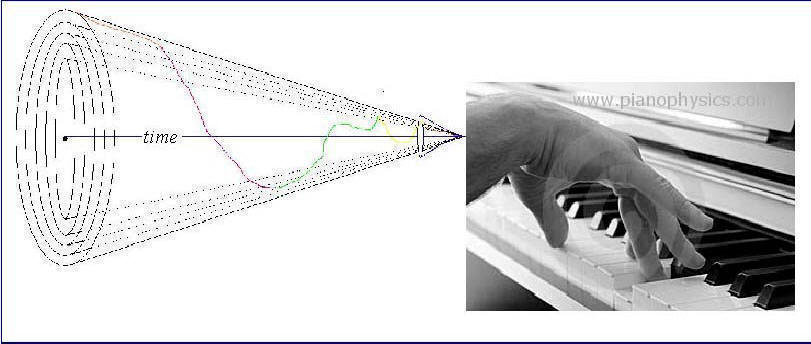The "point of touch" is a singularity interpreted as a wake of progressive impulses and a simultaneous and characteristic mechanical phase-difference between the bodies motion of the piano action mechanism, it is a physical-perceptive entity
The point of touch is physically produced in the activation of the piano key and is propagated through the piano action gears. Its flux can be expressed as the propagation of the energy induced on the Key in terms of instantaneous transmission of pressure.
A flow of "something" presupposes an origin, a reservoir of that which flows. Some questions are immediately placed: where it is coming from this point?, where it is going to?, and if is possible to suppose a loop what kind of variation follows in time? I will start saying something that may appears obvious but it is not in this context: no musician can exactly play in the same way the same notes sequence twice. Or "nobody crosses two times the same river" - Heraclitus 576 AC.
 This phrase is not circunstancial here, the point of touch is originated as a thought in the brain of the musician, the concept is more apparent playing piano but can be reproduced in whichever musical instrument. Gesture is the manifest way of the point, movements and harmonious sounds render possible to express infinite possibilities of psychic expression, the weight of the shoulder, arm, forearm, and hand of the pianist make real such a perceptive entity, focusing mainly towards the fingers its relative flow through neuro muscular patterns. I consider sequential movement representations based on such a correlated neuronal activity can be analyzed under statistical basis and human body mechanics approach, in some period of play time.
This phrase is not circunstancial here, the point of touch is originated as a thought in the brain of the musician, the concept is more apparent playing piano but can be reproduced in whichever musical instrument. Gesture is the manifest way of the point, movements and harmonious sounds render possible to express infinite possibilities of psychic expression, the weight of the shoulder, arm, forearm, and hand of the pianist make real such a perceptive entity, focusing mainly towards the fingers its relative flow through neuro muscular patterns. I consider sequential movement representations based on such a correlated neuronal activity can be analyzed under statistical basis and human body mechanics approach, in some period of play time.
Peripheral skin fingertips terminations nerves determine tactile sensation intensity, considering fingertips surface are provided with these touch sensitive papilas my developing model states that the total amount of data (neural, haptic, and kinaesthetic) converges in time over infinitesimal areas from papilas to contact zones of piano Key. Every playing finger follows Euclidean space trajectories mathematically represented as a composed path through fragments of concentrical conical surfaces, in other words, every finger at playing cross a spatial trajectory over concentric conic surfaces until the moment of contact with the Key (observe figure):

The interaction body-instrument determines special individual hands movements with which the flux of the point of touch evolves; these movements obbey to inspirational thoughts from the brain neural conections of hypothalamus cortex, which is under intense emotional abduction. I presume there exist the theoretical basis of closing of the loop with the phenomena attributed to aural aspects. Should you want to read about this topics on my thesis please open this and this windows, among others pages (or from page 68 to 95 and next, in the pdf document, if you prefer).
I would like to exchange ideas with theoreticians in pure mathematics to discuss topics related to the analysis on symmetric cones, which is a subject of growing relevance in multivariate analysis and number theory as has been mentioned, it embraces several fields of pure mathematics as invariant differential operators, Jordan algebra, spherical polynomials, multivariate hypergeometric functions, holomorphic functions on bounded symmetric domains of tube type, and the like... At the moment (august 2007) I would like to exchange comments and discuss about some unpublished equations on warped shape concentric symmetrical cones. I write again and again these equations to get the exact meaning of "dimensional data flow" (please contact me).

The main aspect of this work has been to model of the magnitudes that describe the acoustic stiffness of the piano action structure, considering as well the flow as the fundamental asset of the theory.


